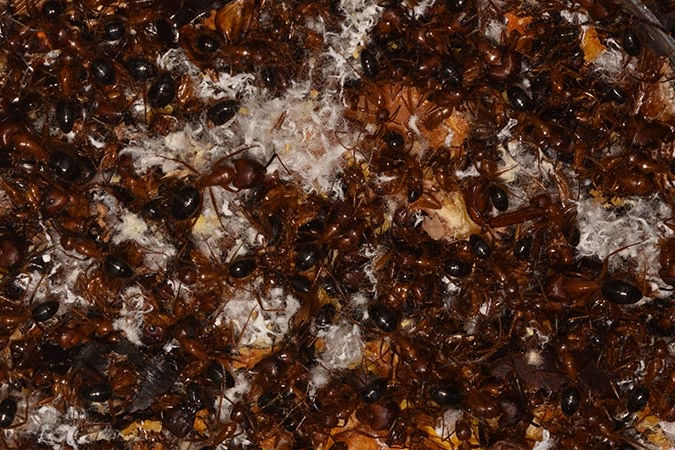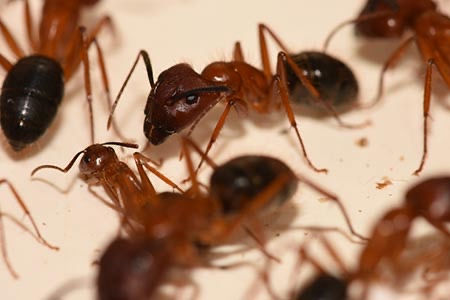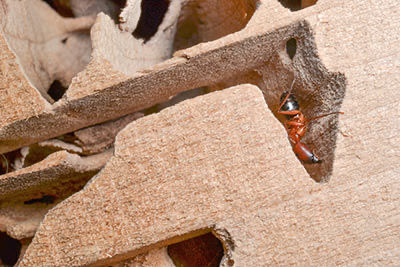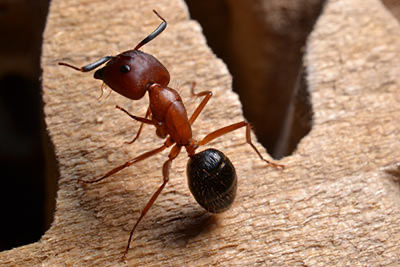How Carpenter Ants Can Damage Your Home: Signs and Solutions
- Ohio Pest Control

- Jan 16
- 5 min read

Carpenter ants, one of the most common household pests across the United States, can pose a significant threat to the structural integrity of your home. Unlike termites, these ants do not consume wood; instead, they excavate it to create nesting spaces, potentially causing extensive damage over time.
Understanding their behavior, recognizing the signs of an infestation, and knowing how to effectively address the problem are crucial steps in protecting your home. This blog will guide you through the key aspects of carpenter ant infestations and offer practical solutions to keep your living space safe and sound.
Understanding Carpenter Ant Behavior

Carpenter ants are notable for their size and distinctive appearance. Typically ranging from 1/8 to 1/2 inch in length, these ants can appear in hues of black, red, or brown. In the eastern United States, the black carpenter ant, known as Camponotus pennsylvanicus, is common, while the western regions often encounter species like Camponotus modoc.
These ants are renowned for their nesting habits, as they prefer to establish their colonies within wood. Unlike termites, carpenter ants don’t eat the wood; instead, they hollow out galleries to create their nests. This behavior can lead to significant structural damage, especially in wood that is already softened by moisture or decay.
Carpenter ants exhibit a fascinating swarming behavior during their mating season. Typically appearing from May until August in the east and from February through June in the western regions, the swarmers—winged reproductive ants—emerge in search of a mate. After mating, the males die, and the inseminated females seek new sites to begin their colonies. This lifecycle reinforces the importance of addressing infestations promptly to prevent further expansion within your home.
Signs of Carpenter Ant Infestation

Detecting a carpenter ant infestation early can prevent extensive damage to your home. One of the most telling signs is the presence of small openings or "windows" on the surface of wood. Through these openings, carpenter ants expel debris that consists of sawdust-like shavings, often found mixed with fragments of insulation or insect body parts. This accumulation of debris below such holes is a strong indication of an infestation.
Another clue of carpenter ant activity is a rustling sound coming from within walls or wooden structures. This noise is produced as the ants work within their galleries, particularly when they are disturbed. These galleries, intricately carved into the wood, often follow the grain, appearing smooth and sand-papered.
Carpenter ants are particularly attracted to areas with moisture problems since they prefer wood softened by fungus for easier excavation. Therefore, homes with leaks or high humidity levels are more susceptible to infestations. Being aware of these signs can help homeowners take prompt action to mitigate potential damage.
Damage and Prevention

Carpenter ants, although not known for eating wood, can cause significant structural damage to a home by hollowing out galleries for their nests. This can weaken beams, support structures, and other wooden elements, leading to costly repairs. The ants are particularly attracted to areas where wood has been softened by moisture, making water-damaged spots in a house prime targets for infestations.
Preventing a carpenter ant infestation involves proactive measures to manage moisture and maintain the integrity of your home's structure. Regularly check for and repair any leaks in the roof, walls, or plumbing to reduce moisture levels. Ensure that gutters and downspouts direct water away from the foundation to prevent pooling water, which can attract ants.
Additionally, maintaining the landscape around your home is crucial. Trim tree branches and shrubs that might provide a bridge to your house, and keep firewood and other wooden materials away from the foundation. Also, seal any cracks or openings around doors, windows, and the foundation to block paths into your home. Implementing these preventive steps can significantly reduce the risk of carpenter ant invasions.
Solutions and Treatments
Addressing a carpenter ant infestation requires a strategic approach to effectively eliminate the ants and prevent future invasions. One of the most effective methods is a thorough perimeter treatment using a non-repellent pesticide, which helps eradicate ants by allowing them to carry the pesticide back to their nest. Ensuring that the treatment covers areas like the bottom siding-to-foundation wall junction can increase its effectiveness.

If you're dealing with a recent satellite colony, spot treatments in active areas with a non-repellent pesticide might suffice to deter the ants. Also, addressing any sanitation issues inside the home is critical, as ants exploiting internal food sources might not cross treated areas outside.
In cases where the infestation persists despite perimeter treatments, it may be necessary to locate and directly treat the nest. Signs to look for include sawdust piles and rustling noises inside walls. Once identified, nests can be treated with dust or sprays specifically designed for indoor use. This may involve drilling into walls or wooden structures to ensure the pesticide reaches the core of the infestation.
Persistent and thorough treatment, combined with eliminating moisture and food sources, can effectively control and resolve carpenter ant infestations, protecting your home from further damage.
Seeking Professional Assistance

While some ant infestations can be managed with diligent prevention and treatment efforts, there are times when professional assistance becomes essential. If the infestation is extensive, or if treatments have been unsuccessful, engaging the expertise of pest control professionals may be the best course of action.
Professionals have access to specialized tools and knowledge that enables them to accurately locate and target even the most hidden carpenter ant nests. They can employ advanced techniques and use more potent treatment solutions that are safe for inhabitants while being highly effective against pests.
Safeguard Your Home from Carpenter Ant Damage

Carpenter ants, though small, can pose a significant threat to the integrity of your home by creating intricate galleries within wooden structures. Understanding their behavior and recognizing the early signs of infestation are crucial for preventing extensive and costly damage. Through proactive measures such as managing moisture levels, maintaining your home's exterior, and applying effective treatments, you can protect your home from these relentless pests.
When the challenge of controlling carpenter ants becomes too great, seeking professional help ensures a comprehensive and effective response. Ohio Pest Control, with over 50 years of experience, stands ready to assist with all your pest management needs. Our team is dedicated to providing honest, transparent, and reliable services tailored to your specific situation. By understanding the unique patterns of carpenter ant behavior and implementing targeted treatments, we ensure that your home is not only free from these pests but also safeguarded against future issues.
Don’t let carpenter ants compromise the safety and comfort of your home. Contact our professionals today to secure a pest-free environment for you and your family.




For homeowners in Vaughan, getting professional ant control Vaughan services can prevent infestations before they become a major issue!
Professional ant removal near me made my home pest-free again!